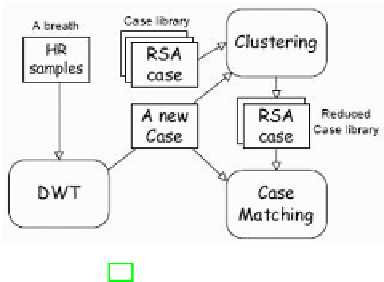Information Technology Reference
In-Depth Information
Fig. 2.
The retrieval process in [37]. Time series of heart rate (HR) samples, which
correspond to a breath, are matched for similarity with clusters of time series (the
picture is taken from [37]).
be supported on how to solve current problems similar to those occurred in
the past. In [33] time series are transformed by means of DFT, and only the
first coecients are kept for similarity calculation. Retrieval is implemented as
a multi-step procedure, as described in figure 1. In particular, a first classifica-
tion step exploits k-Nearest Neighbour in the static features space, in order to
focus retrieval on a limited portion of the case base. Intra-class retrieval in the
most similar class with respect to the input situation is then implemented. In
particular, the most similar cases with respect to each one of the time series
features, considered individually, are first extracted. To guarantee that retrieved
cases have the required level of similarity on each time series feature, the inter-
section of the sets of returned cases is then computed. On the result set, global
distance is finally calculated, by computing a weighted average; returned cases
are ordered in terms of overall distance.
DWT in Respiratory Sinus Arrhythmia.
A significant application of DWT-
based dimensionality reduction in medical CBR can be found in [35,37]. The
tool is able to classify Respiratory Sinus Arrhythmia (RSA), i.e. the respirations
affecting the heart rate: persons do sometimes have physiological or psychological
(e.g. stress-related) disorders, that appear as dysfunctions in the RSA patterns.
The system uses CBR as the method for classification of dysfunctional patterns
within the RSA. CBR is a very suitable methodology, because the domain is
not fully understood. In the system, RSA time series are first dimensionally
reduced by means of DWT; then the most similar clusters of previous cases are
retrieved from the case base, in order to support disorder classification. The
system architecture is described in figure 2. In particular the authors rely on
Daubechies D4 DWT, which prove to be very well suited for biomedical time
series retrieval, since they allow to detect a specific form of oscillating sequences.
The authors were also able to compare the use of DWT to the one of DFT, since
they originally applied DFT to the same domain in [36]; in RSA classification,
they have obtained an increased retrieval rate when resorting to wavelets.






Search WWH ::

Custom Search